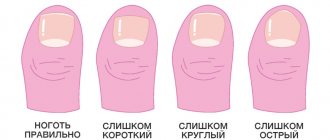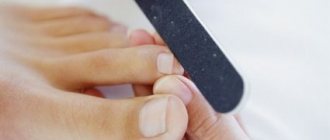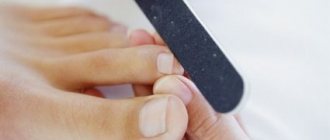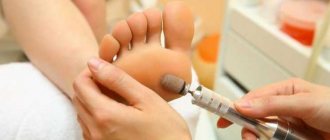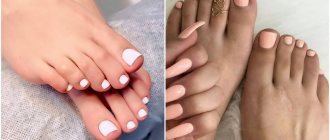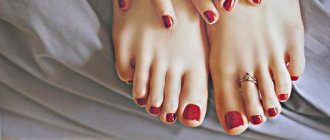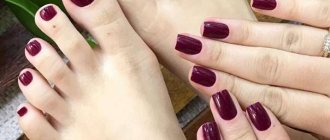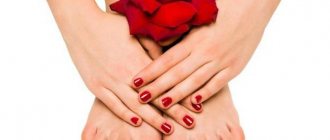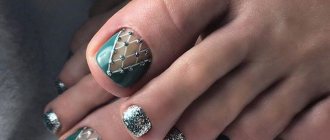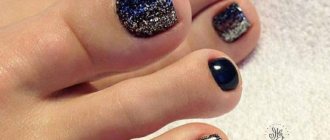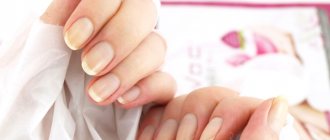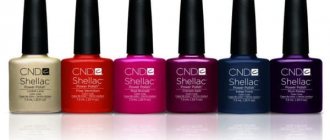From this article you will learn:
- What does combined pedicure mean?
- How does a combined pedicure differ from other types?
- What is the advantage of a combined pedicure?
- Who is contraindicated for combined pedicures?
- How is a combined pedicure performed?
Beautiful and healthy nails are a very important factor in your overall health. We spend a lot of time on our feet, so we need to take care of them not only for the sake of appearance, but also so as not to feel heaviness and fatigue. Calluses, corns, and ingrown nail plates interfere with and disfigure your gait. A combined pedicure, that is, a combination of trimmed and hardware, solves many problems.
If you need maximum results with little time investment, then this is an excellent option. It represents a whole range of foot care. First, the master performs general hardware processing, then grinds and goes through the entire foot in detail.
Main types of pedicure
Today, salons are ready to offer clients different types of pedicures. They differ in the set of devices, tools and care products, but they have the same goal - to tidy up the feet and toenails.
Each type of pedicure has advantages and disadvantages, as well as contraindications. Cosmetic procedures should bring pleasure, so it is necessary to study them so that in pursuit of fashion and beauty you do not harm yourself.
Pedicure happens:
- edged (classic);
- dry (unedged), or European;
- hardware;
- combined;
- SPA technique;
- pedicure with fish;
- Japanese.
The list is constantly being updated and changed. Cosmetologists never cease to find new ways to perfection.
Classic pedicure
Everyone has known him for a long time. Many people do this pedicure at home on their own.
Everything is simple here:
- Steam your feet in hot water;
- Use a pumice stone or a brush to remove corns and calluses;
- We process the nails with a file and give them the desired shape;
- Cut the cuticle.
A specialist does all this quickly and inexpensively. Often women master this technique by looking at a master, and then do it in the bathroom or sauna. But this type of nail treatment is fraught with significant disadvantages.
What are the dangers here?
- Since the feet are placed in a bath of water or in special hydromassage devices, there is a high risk of contracting a fungus or other infection. If you do not regularly disinfect all equipment used, the result may be itching, burning, and damage to the nail plates. Not a good feeling!
- The technician uses sharp instruments to trim the cuticle and can damage the skin. Due to the large flow of visitors or simply in the hope that “this will do,” fixtures and equipment are not always thoroughly disinfected. As a result, there is a risk of getting even such deadly diseases as hepatitis and AIDS.
- Too zealous specialist. Sometimes, due to inexperience, too much skin is cut off from the foot, it becomes thinner, and walking becomes uncomfortable and even painful. Regeneration in the damaged area intensifies, and the procedure has to be repeated earlier than usual. Excessive zeal will not do any good.
European pedicure
European pedicure allows you to work without water baths and sharp instruments, which reduces the risk of infection. In principle, the craftsmen adhere to the same scheme, but using other, more gentle devices.
Stages of European pedicure:
- The specialist uses a special composition to soften the cuticle and then push it to the edges of the nail. Due to this, cuticle growth gradually slows down.
- Use scissors and tweezers to process nails and give them shape.
- Using graters and scrapers, carefully removes rough skin from the foot.
A significant disadvantage of this process is that it requires about six sessions to provide quality care. Not everyone can find so much free time to visit a specialist. But the advantages of this technique should not be discounted either.
Hardware pedicure
A hardware pedicure is a fairly simple procedure. To carry it out you need a special device and a little operating skill.
The device is equipped with cutters rotating at a given speed. Rough attachments easily clean off the stratum corneum of the skin, move and remove the cuticle, and shape the nail plate. Nails become smooth and neat. During the process, the master uses skin softening products. They prepare the feet for a more comfortable treatment. There is no risk of injury or infection.
This type of pedicure allows your feet to look well-groomed for a longer time. It is not surprising that a hardware pedicure session costs more.
Spa pedicure
The goal of a SPA session is not only to treat the feet, but also to ensure that the client rests, relaxes, and, in general, gives the client maximum pleasure.
To do this, a special atmosphere of privacy is created, soft music sounds, the master uses special ingredients, oils, healing mud, exfoliating mixtures, and water from thermal springs. All this works together for special care and care.
However, it should be borne in mind that this pedicure is suitable for people who constantly care for their feet. If there are fungal diseases or ingrown nails, you first need to cure them. And the higher cost of the procedure also serves as some limitation.
Recommended articles on the topic:
- Manicure ideas – bright, fresh, fashionable
- Removing warts with a laser: technology, consequences, recommendations
- Stone massage: description, benefits, methods
Combined pedicure – what is it?
So we got to the combined pedicure that interests us. What does this include? This is a combination of hardware pedicure and classic trim. It is used for more gentle processing, although there is no limit to perfection.
The master, at his discretion, sometimes supplements it with other cosmetic procedures, for example, peeling. First, the foot is coated with glycolic acid, wrapped in a towel and film, and left for half an hour to soften the top rough layer. Then carefully clean everything off with a brush or pumice stone and apply a rich cream.
This is an effective and simple combination that leaves your feet as soft as a baby's. The only thing is that you need to wear thin socks for several days, as the chemical peeling continues to take effect and the skin flakes off.
Pedicure with live fish
The exotic Asian pedicure technique that you see in the photo came to us quite recently and has won its place in the cosmetology services market.
It is carried out simply: after disinfection, the client dips his feet into a small pool with Garra rufa fish, and the feast begins. The keratinized skin serves as food for these babies. So there is no need for files, scrubs, brushes and pumice - the fish will do the work of a pedicurist. All that remains is to shape the nail plates.
A positive side effect is that the fish help heal wounds and cuts on the legs with their saliva. Tissue regeneration accelerates.
Does such an unusual procedure have any disadvantages? Of course yes. And it's not just overpriced. It is quite predictable that such a session cannot be cheap. In some countries, this type of pedicure has been banned due to possible infection from fish.
Japanese pedicure
The original Japanese salon procedure is composed of several elements: foot massage, unedged pedicure, SPA care. To increase the cost, specialists do all this with expensive products of natural origin. But the results are also excellent. The skin of the feet becomes soft, soft and healthy. There is demand - there is supply.
A combined pedicure in the salon allows you to tidy up your feet in the most advanced cases. It combines unedged and trimmed techniques for treating nails and feet. Sometimes the specialist also performs hardware grinding to remove calluses and corns, and adds elements of SPA care as a pleasant bonus.
Read material on the topic: Medical hardware pedicure
Steaming technology
The combined version is very often performed with a little steaming of the legs. This method must be used when a woman or man has problem areas. A cutter with a disposable cap can only remove the top layer of dead cells.
If deep cleansing or foot peeling is required, it is better to resort to the steaming option. For this procedure, a scrub is most often used, but sometimes it is combined in the care line - this is a peeling mousse. As a result, an integrated approach replaces any foot soaking in the bath.
After complete cleansing of the foot with the use of cosmetics, the feet must be thoroughly dried, and only then begin to remove the pterygium and cuticle. As soon as the cuticle is wet and does not need additional moisture, you can immediately take the pusher and protect the film with the plate. Further actions have already been determined. The master will use pliers, smooth out uneven cuts with a device with cutters and adjust the length of the nail.
Who is suitable for a combined pedicure, its technology
If you don’t like the classic system with steaming in a bath, hard brushes and cutting the cuticles with sharp scissors, then a combined pedicure is for you. In addition, if you have not treated your feet for a long time, there are painful calluses, cracks, the cuticle has grown, the nails have become brittle, then the master’s work will require a combination of several techniques.
On the other hand, there are clients who do not like European pedicures with unedged techniques. They believe that it does not cope well with rough skin on the feet. The master needs to be able to make combinations for any, even very advanced cases. Fortunately, there are enough options and means for this.
With a combined session, the likelihood of injury to the foot and toes is minimal. Those who have sensitive, thin skin can perform a pedicure with heating in a bath, scrub treatment, massage, but without the use of sharp metal objects. And those who prefer untrimmed technology can turn to the effective methods of the classic version: after hardware grinding and softening, cut off the cuticle.
Read the material on the topic: How to strengthen peeling nails
How to decorate your toenails
Fashion trends in pedicure today dictate the following conditions: the design of fingernails and toenails should, if possible, either match or be in the same color scheme. And it looks really stylish! When making a specific design on your hands, you can immediately ask the master (or yourself) to do it on your feet.
By the way, a pedicure in a salon will cost more. Designing on toenails is more difficult - the area to work on is usually smaller. There is a universal option that suits everyone without exception - a French jacket. On the feet it looks just as impressive, stylish and fashionable as on the hands. Therefore, if you have absolutely no ideas on how to complement your pedicure, you can turn to the timeless classics. If necessary, the specialist in the salon can increase the free edge to create an even smile line. And even draw something on the thumb. And yes, simple polish on your toenails lasts much longer than on your hands. Therefore, you can ignore the expensive procedure with gel polish, using the most ordinary and familiar varnish.
Principles and sequence of combined pedicure
Basically, specialists make up a combination of hardware pedicure, classic trim and elements of SPA care. First of all, foam, essential oils, soap balls or a special composition for maceration are added to a bath of warm water. After softening the skin of the feet, they are massaged with various scrubs (sugar, salt, mineral) and rinsed.
The next step is to remove the layer of rough outer skin on the feet and heels with a pumice stone or a special grater. To avoid cuts, you need to take precautions. If injury does occur, it is necessary to quickly treat the area with hydrogen peroxide or a hemostatic pencil.
For clients who prefer soft grinding, we can offer whetstones with a rough surface or equipment with different attachments. Dry skin needs to be treated. Otherwise, you can injure it or cause a hangnail to appear. You can also change attachments on the device and alternate them with files.
First, use a tool with a coarser abrasive to remove the topmost layer of cells. At the next stage, bring the area smooth with soft brushes, smooth and polish the feet, fingers and the space between them. A special machine is used to cut calluses. The blades on it are changed for disinfection.
You can avoid steaming in hot water if you don’t like it. Instead, the specialist will suggest chemical peeling, that is, softening using a cream with fruit acids. In just five to seven minutes, the skin becomes looser on top, and can be removed with a brush and rinsed. This stage is mainly suitable for those who do pedicures regularly and whose dermis is not too rough. But you can deal with it differently: first, carefully scrape off the dead skin, and then apply a gel with acids. It is necessary to strictly observe the exposure time so as not to burn your feet.
Processing or cutting the cuticle is the next step. A softening cream, gel or pencil with a special composition is applied to the skin around the nail. Then, with a metal pusher or an orange wood stick, it is pushed aside for cutting with wire cutters or nail scissors. If you used a bath and the skin is soft, you can remove it without cuticle liquid.
After removing the cuticle, rinse your fingers and wipe dry. For nutrition and greater softness, a cream containing urea is applied to the feet. After cleansing, the skin especially needs nutrition and hydration.
The next stage is nails. To prevent delamination and ingrowth of the nail plates, you need to shorten the overgrown edge evenly with flat-cut pliers or tweezers. To process brittle and brittle plates, it is better to take a coarse-grained cardboard or ceramic file. For final polishing, a hardware pedicure with special attachments or a manual pedicure with polishing bars is suitable. Or use a fine-grained glass file.
So, you need to choose a combined pedicure if:
- you think that the hardware only “strokes”;
- you have sensitive skin, you are afraid to injure it with a classic trimmed pedicure;
- the cuticle grows on the nail, it is difficult to remove it with a device;
- It is necessary to remove corns and calluses.
The use of the device and conventional instruments gives the best result, regardless of the initial condition of the feet. SPA treatment can provide additional care thanks to natural extracts and herbs.
Read material on the topic: Curvature of the nail plate
Peculiarities
A combined pedicure is a procedure that combines several technologies at once. Using this method, the master manually gets rid of the cuticle, but uses a special device to treat the feet and the skin around the toes.
In the case of a classic pedicure, the cuticle is removed well, but the heels may not be completely cleaned or may be damaged by cosmetic instruments. If you use only the hardware option, then you may not be too satisfied with the area at the base of the nail, because in this way the cuticle is less easily removed and the nail plate may be damaged.
A combined pedicure has a number of advantages, but for this you need to go to a real professional. Beginners or unscrupulous professionals may neglect the rules for performing the service, which may lead to a less effective result.
Advantages and disadvantages of combined pedicure, contraindications
Advantages of a combined pedicure:
- It allows you to remove many of the problems that visitors come with: small cracks, ingrown toenails, which very often annoys you when walking, rough skin, large cuticles. Corns and calluses disappear after a bath and treatment with a device with attachments.
- Even if this is your first time visiting a beauty salon specialist, a combined manicure or pedicure will immediately correct many shortcomings. The effect lasts for almost a month.
- A combined pedicure session lasts from an hour to two. It all depends on the condition of the patient’s legs, the skill and professionalism of the specialist. The approach is individual, the combination of techniques may vary.
- SPA care, masks and application of varnish and drawings are additional steps. Time is allocated for them separately from the main procedure.
Features and disadvantages of combined pedicure
Classic and combined pedicure - what's the difference? And what is the difference between a hardware pedicure and a combined one? Let’s answer this: women who consider these methods individually insufficient prefer to combine. They want the best of both worlds. The effectiveness of this option is higher, the comfort and softness of the feet last longer.
To perform a combined pedicure, you need to be an experienced master, go through a certain school, have certificates and diplomas of completion of training. Some beginners adhere to the rule: “Do not sand on wet feet.” It is better to go to recommended specialists. Follow the principle: “Trust, but verify.”
A distinctive feature of the combined pedicure are SPA elements. That is, the master uses essential oils, creams, gels based on natural ingredients (fruit acids, herbal and plant extracts). Accordingly, they are more expensive.
A specialist can offer different combinations and replace them as agreed. For example, take a scrub with large grains instead of hardware exfoliation. Or use both.
Each person is individual. There are always contraindications.
So, a combined pedicure should not be done if:
- the client is sick with diabetes, viral hepatitis;
- there are malignant tumors;
- blood does not clot well;
- there is a fungal infection on the legs;
- weak immunity;
- you are currently pregnant or breastfeeding;
- there is an allergy to drugs;
- there are viral infections in the blood;
- liver or kidney diseases are observed.
Products to help maintain your pedicure
- Regenerating foot cream “Intensive Care”, Garnier - the problems of drying out and the appearance of microcracks on the skin of the legs and feet are solved by a regenerating formula based on maple sap. Intensely nourishes, eliminates peeling and discomfort.
- Care for dry and rough areas of skin, Kiehl's actively moisturizes and nourishes thanks to the content of glycerin, shea butter and avocado. Suitable for dry and cracked skin.
- Nourishing body scrub “Precious Beauty Scrub”, Garnier - seeds of the cupuaçu fruit tree clean and polish rough areas on the feet, and a complex of four oils moisturizes, softens and nourishes the skin of the feet.
How to do a combined pedicure
What are the stages of a combined pedicure procedure in a salon?
- Sterility is the main rule. Disinfect all equipment and wash your hands thoroughly. It is even preferable to do this in front of the client to avoid unnecessary questions.
- Examination of feet, heels, nails. The visitor can also indicate problem areas. The wizard determines the sequence and stages of processing. For advanced and complex cases, a series of procedures may be required.
- Foot bath. Serves to cleanse and prepare feet. Warm water with sea salt and essential oils relaxes the client and softens the skin.
- Pedicure, sequential treatment of heels, feet and toes. Cuticle cutting, nail shaping, polishing, etc.
- Massage with hydration and nutrition. The skin should completely absorb the cream, after which the procedure can be considered complete.
These stages of a combined pedicure are basic. Different specialists can add something of their own or take into account the wishes of clients. Discover new opportunities for cosmetic services in the field of pedicure.
Read material on the topic: Removing an ingrown toenail and how to avoid it
Combined pedicure with bath
To prepare the client’s feet for a combined pedicure session, you need to:
- Carry out thorough disinfection of the instruments used, wash your hands. Before each new client, it is necessary to prepare a workplace.
- Remove old varnish, if any.
- Examine your feet for problems. Draw up a list of processing stages together with the client. Determine how many sessions will be required.
- Prepare a bath with a special composition to soften the feet. The client relaxes, the skin on the legs becomes soft from the effects of sea salt and oils. To clean and remove unpleasant odors, you need to add an antiseptic.
- After the bath, dry your feet thoroughly and dry with a towel. It is not advisable to start treating wet feet.
If conditions do not allow or the client wants it, instead of a bath, you can wrap your feet with a thin plastic film on top of the applied softening cream. The holding time depends on the condition of the visitor’s feet. On average it is five to six minutes. Then the skin of the feet is wiped with a towel.
Combined dry pedicure
In this case, the legs are not steamed. The first stages: disinfection, preparation of the workplace and preliminary inspection remain the same.
Instead of a softening bath, a remover is applied - a special cosmetic alkaline solution of sodium hydroxide. They coat areas with calluses, corns, and rough skin. Cover the top of the legs with napkins and wrap them in cling film for about ten minutes. The master determines the time himself depending on the complexity of the processing.
The remover must be used with caution:
- it should not be applied if there is damage to the skin: scratches, cuts, wounds;
- processing time is no more than ten minutes;
- Apply and remove only with gloves.
- Remover removal. Carefully, wearing gloves, unwind the film and wipe off the layer of product with a napkin.
- Foot treatment. Using the device at low rotation speed, the softened skin is removed, the feet are ground and polished. They pass carefully where the remover was applied.
- Working with nail plates and cuticles. If varnish remains, it is removed. Nails are trimmed beautifully. The cuticle is moved and processed. The device is used to fine-tune and adjust each nail.
- Nutrition and decorative coating. At the end, massage with nourishing cream. If the client wishes, nail polish is applied.
The final design depends on the visitor's requests. The craftsman usually has a lot of different materials in stock. This point is discussed separately, as it requires additional time. This also applies to SPA care and masks.
Read material on the topic: Body care procedures
What tools do you need?
The device is a milling cutter. It is important to pay special attention to the manicure cutter, since the final result depends on its quality. Do not give preference to cheap models - even at high speeds they are inferior to their quality competitors. The minimum power of a good device is 60 watts. For example, the Strong 210/105L milling cutter has 64 watts of power and is equipped with all the modes necessary for a combined manicure.
Top 7 models of devices for manicure and pedicure: select and evaluate
Key rules for working with a router:
- Do not move the nozzle over the same place. As a result of friction, heat is generated, which causes significant discomfort;
- Don't work with your arm suspended. The hand must have a stop in the form of your own finger or the client’s finger;
- Work intensively, but carefully. Slow movements can also cause an increase in temperature and further delay the process;
- Don't be afraid of high revs. The device must be set to at least 17 thousand revolutions. With the correct positioning of the hand and the inclination of the nozzle, high speeds will not cause any unpleasant sensations.
Milling cutter The “Flame” cutter with a red abrasive ring with a diameter of 23 mm is ideal for a combined manicure. This attachment is universal and suitable for working with cuticles and treating periungual skin. All manufacturers conventionally mark the hardness of the nozzle with a corresponding colored ring under the tip:
- The yellow cutter is very soft;
- Red – soft;
- Blue – medium;
- Green – rough;
- Black is very rough.
When choosing a cutter for a combined manicure, pay attention to the shape of the tip. The same cutter from different manufacturers can differ in shape and length, while still having the same diameter.
Milling cutters for the device: types, purpose, how to choose and use in manicure and pedicure
The tip itself can be divided into three parts:
- The belly is the most convex part of the nozzle with the largest diameter. Depending on the shape of the cutter, the belly can be exactly in the center or shifted to the base of the tip;
- The nose is the narrowest, pointed part;
- The cheek is the transition of the cutter from the belly to the nose.
The most convenient and safe cutter has a symmetrical shape without displacing the widest part of the tip towards the base. The tip of the cutter should be pointed.
Pusher. When choosing a tool for a combined manicure, pay attention to its overall length - a base that is too long makes work difficult and forces the hand to take an unnatural position. It is better to give preference to shortened options with a blade that is not too wide, for example, Mertz.
Types of pushers - comparison, characteristics, operating rules
Nippers or scissors. What to give preference to – decide for yourself. Pay attention to the Nghia brand, which offers high-quality tools with good factory sharpening.
Nippers for manicure and pedicure - types, brands, selection criteria and operating rules
Nail scissors - types, proper use, choosing the best
Where in Moscow to sign up for a combined pedicure
Nowadays, you no longer have to spend a lot of time performing complex and unpleasant procedures at home. It is much easier to seek help from real professionals - the Veronika Herba beauty and health center, equipped with effective and modern equipment.
Why clients choose Veronika Herba Beauty and Health Center:
- This is a beauty center where you can take care of yourself at a reasonable cost, while your face and/or body will be treated not by an ordinary cosmetologist, but by one of the best dermatologists in Moscow. This is a completely different, higher level of service!
- You can receive qualified help at any time convenient for you. The beauty center is open from 9:00 to 21:00, seven days a week. The main thing is to agree with your doctor in advance on the date and time of your appointment.
Sign up for a consultation with a specialist by phone +7 (495) 085-15-13
, and you will see for yourself!
Dry option
A combined pedicure and manicure can be performed without applying any products. The work is carried out mainly by a device that cleans the pterygium and nail cuticle. Changing cutters in stages helps to prepare them as much as possible for cutting with tweezers.
It is very important to try to make the cut in one fell swoop. This requirement is put forward so that the client does not develop raised areas while wearing them, which come out mainly on the side bolsters.
Masters especially value dry pedicure, as it is ideal for subsequent artistic processing of the plate.
The main work of a dry combined pedicure is to design the plate. All efforts are aimed at design to make your fingers look well-groomed. Dry pedicure is also very good to wear. You can use it for about two months without additional correction. You can perform a dry pedicure yourself at home if you have a device that you can use at any time.
